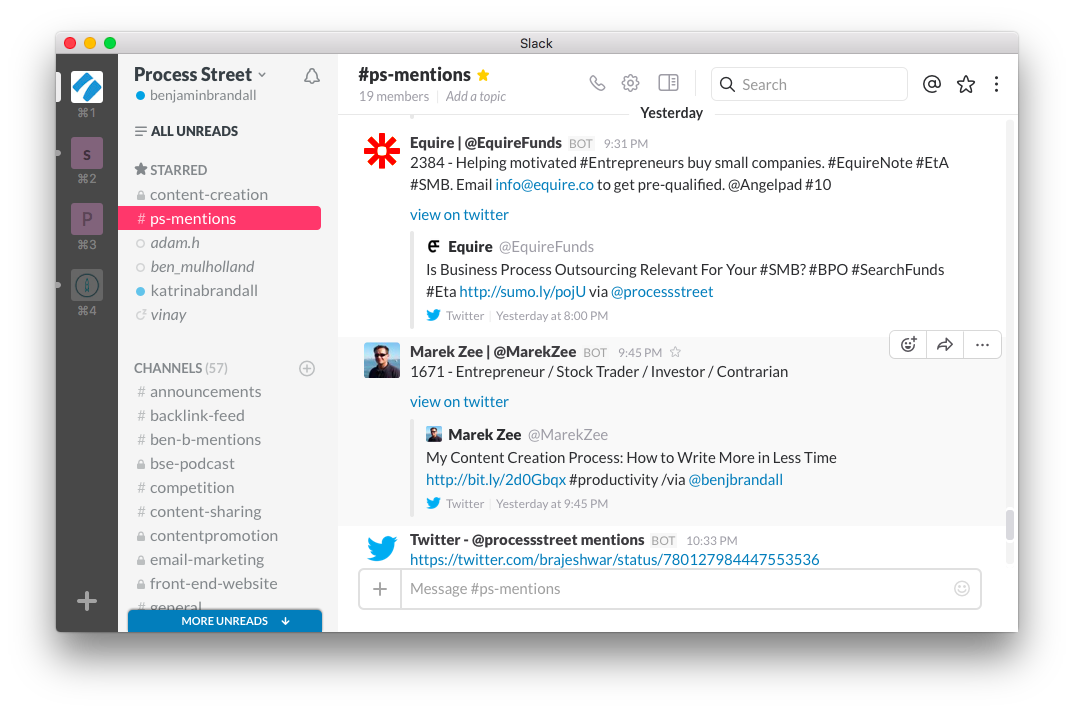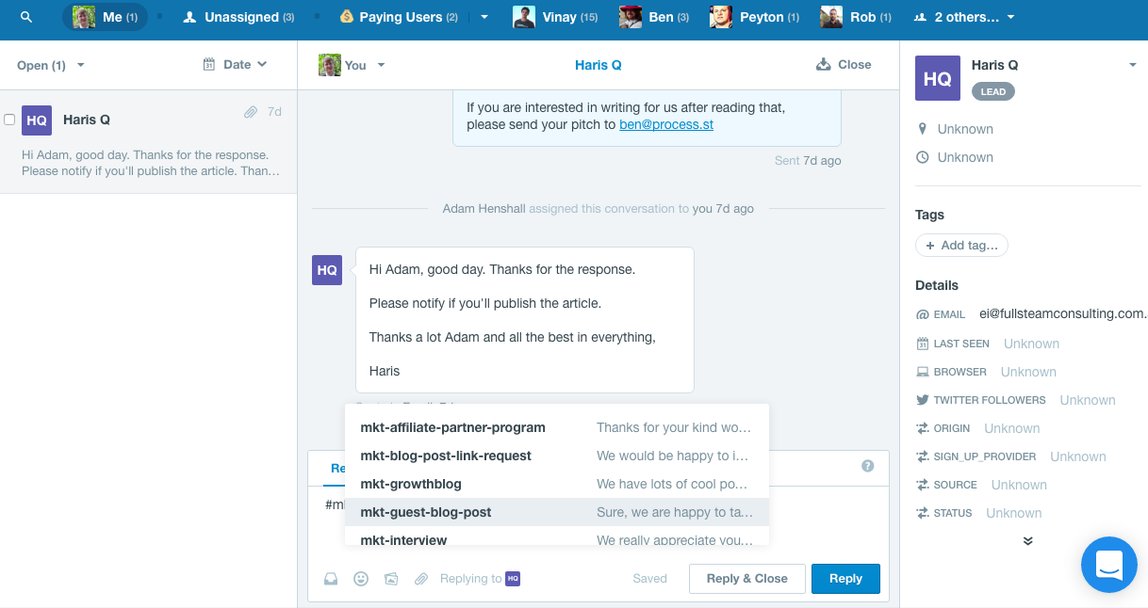
The days of a business being run on email and local spreadsheets are long gone. No more sending over files, losing data and waiting for hours to hear back from a co-worker.
Thanks to SaaS apps, the team here at Process Street are able to efficiently collaborate and consistently create a high volume of quality content.
Our main tool of choice is obviously Process Street itself, as it’s the easiest way to manage company processes. Our process templates allow us to approach each piece of work with a consistent approach.
A process template can be run as a checklist for one person, or involving multiple people. We use features like task assignments to make sure the designer creates a header image, the team can give feedback, and the editor can make final reviews and publish.
Process Street is like the spine for everything we do. Branching off from there you’ll find a host of other tools which help us do all our other tasks. We love tools which are cloud based, easy to use, and can integrate with Process Street to automate tasks.
These tools help us to produce our content and keep organized as a team.
Here are the five main online collaboration tools we use to do that — some you’ve almost definitely heard of, others may not be so familiar.
Regardless, I hope this toolbox helps you collaborate with your team!
Quip: a collaborative writing app for content teams
After a lot of changing between tools, we settled on Quip because it’s perfectly suited for content teams. The main screen is a timeline of edits and new documents, and the writing environment feels natural and makes anything you write look great, putting it way above Word or Google Docs.
With comments, trackable revisions and granular sharing settings, Quip has become the home base for all of our content, both internal and external. 
Plus, if you do ever need to collaborate with someone over Google Docs if they don’t use Quip, you can export to HTML in a few clicks and then copy/paste over without any formatting errors.
Pricing: Free trial (based on usage, not time), or $50/month for a team of 5 users.
Slack: used for much more than just chat
When you explain the concept of Slack, it’s hard to convey exactly why it’s better than something like Facebook messenger or even Skype. The fact is, Slack is a blank slate just waiting for useful integrations to be plugged into it.
For example, we’ve integrated it with a BuzzSumo RSS feed that updates for every backlink we get. That way, we know which posts to add to our promotion process. We also have a channel linked to Twitter, so we can see all mentions of our company and employees in real time without leaving Slack.

For marketing operations, we connect Slack to Trello and get updates on tasks and projects automatically fed through to the right team. This is incredibly useful as content creation updates are centralized and can be tracked easily through various channels.
Basically, Slack is a full dashboard for all company events as well as a place for teams to discuss them (and post silly gifs), making it one of the must-have online collaboration tools.
Pricing: From free, with premium features available for $8/user/month
Trello: for our content calendar and task assignments
While Slack is for real-time updates, Trello is where the real information lives.
Trello is a searchable Kanban board that we use to manage team tasks and blog post writing. On the blog posts board, we have a list of ideas that are moved through the funnel from ‘in progress’ to ‘waiting review’ to ‘published’, with comments to update the team at each stage of the process.
When you assign a due date to a card (a card will contain one blog post, for example), you can then use the Calendar power up to show a calendar of the cards organized by due date. This is a really simple way to create a content calendar with no extra work apart from the usual task management side of things you’d do anyway.

For off-site posts, we also have a column to mark it as ‘sent’ and one where cards are moved if the post has had edits requested.
At a glance, our team knows exactly who’s responsible for what, and what we’re all working on.
Using Zapier, Trello also integrates with a ton of other apps that means you can feed tasks into other apps and have cards created automatically when you run a process, add a row in a spreadsheet, or get an email.
Pricing: Free, with business features for $9.99/user/month
Airtable: our huge data warehouse
While some people might like to manage their spreadsheets with Google Sheets or Excel, we’ve found that to really power things up, you need a proper database.
We manage all of our data in Airtable, from information about blog posts (have they been promoted, who’s mentioned, who shared it, etc.) to data on keyword research. Since SEO is so important for bloggers, we couldn’t settle for storing keyword data in a mess of different spreadsheets sprinkled around other people’s computers, so used Airtable as a base.

Not only that, Airtable also integrates with over 500 other apps by using Zapier. Zapier is an integration platform that makes it easy to connect software without any programming. You can link Airtable to things like Salesforce, Dropbox and Gmail to send your data around the internet and make better use of it.
For example, we store a huge database of contact details for outreach in Airtable, so when we want to send them to our CRM (Close.io) we can just tick a box and it’ll zap it over.
We recently decided to use Airtable to manage content marketing as well as data storage. Much of what we used Trello for (blog calendar, task assignments, content tracking) is now largely housed within Airtable. This decision was made as we found over time that the higher level of detail possible through Airtable’s platform was better suited to our needs for a growing team.
Pricing: Free, with premium starting at $10/user/month
Intercom: for managing guest post submissions
Most blogs with a decent readership will get several guest post requests coming through every week. If there is more than one person on your marketing team, it could be a while before someone gets around to dealing with it in their personal email.
Instead, we use the support app Intercom to manage this so the request is visible to the whole team. Then, the first person with time to respond to the ticket can do so and it won’t keep the contributors waiting.

You can also use Intercom to send saved replies, so generic acceptances, rejections or follow-ups can be typed out in seconds instead of taking more time than they need to.
Since guest post submissions come through the same app as the support tickets and we make a point to have every employee doing support, it also gives the marketing team a great opportunity to read real customer feedback on the product and marketing material, giving us insights into what’s working and what isn’t.
Pricing: Offers a 14-day trial, then $49/month
Which online collaboration tools do you use for team productivity?
There are a ton of collaborative tools out there. And while we’ve tested most of the main ones, there must be some brilliant ones we have no idea exist.
What do you use to collaborate on marketing projects? Let me know in the comments!







Alex Gallia
Alex is a content writer at Process Street who enjoys traveling, reading, meditating, and is almost always listening to jazz or techno. You can find him on LinkedIn here